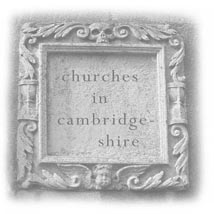Coveney is a little settlement to the north-west of Ely. It is part of a string of settlements – including Little Downham, Witcham, and Sutton – which perch on the old areas of dry ground above the south-eastern edge of the Fens. This lends all of them a frontier character, Coveney even more than the others. We visited on a blisteringly hot day in the summer of 2007, and I spent half an hour traipsing up and down the main (and only) street looking for a key, seeing almost nobody save a few well-fed dogs.
In the end we did manage to get a key – as sod’s law would have it, the keyholder actually lives very close to the church, but in the opposite direction to the way I tried at first. And we were lucky that we got in, because St Peter is surprisingly rich in interest.
The exterior isn’t especially promising - though charming, especially in high summer when it is surrounded by a stand of great leafy trees. The core of the building is the long low 13th century nave. It was extended in the following century to include a new chancel, and the lower part of the west tower, with a processional arch through the bottom stage. The latter finished off in the 15th century. Everything is a little bit run-down, alas; the clunch of the tower has been very deeply weathered by wind and frost, and some of the windows are broken. Inside the south porch, the two shafts acting as responds for the main doorway seem to have been taken away, and never replaced. Plainly, things are tough out here in the Fenny badlands.
Entry is not through the main south doorway, but rather through the vestry in the north-east corner. Inside, the building is as modest as one would expect. There is no chancel arch, so the roof runs the entire length – some of the timbers looked magnificently old, but it’s all very plain. There’s a little more interest in the windows: this is one of those churches where successive generations added new windows to let in more light, and thus provided a catalogue of changing building practices and tastes over several hundred years. The very oldest windows are knife-thin lancets, cut through the thickness of the wall with chunky recesses. Then there are more elaborate Decorated windows in the south aisle, plus a very fine one in the south wall of the chancel which has two piscinae set into its jambs and a low recess that must have at some point accommodated a set of sedilia. Both it, and the more ancient lancet nearby, have scraps of old wall painting (though nothing more exciting than red lines dividing a white field into a block pattern). There are also a few early Perpendicular windows dotted around, including one in the south wall of the chancel. It impinges on the recess of a much older lancet, and includes room below for a chair and a reading desk set within the frame.
St Peter’s real treasures are its fittings. Some of these have been there a long time – I liked the early sixteenth-century seating in the nave, with its big crude poppyheads decorated with faces, a cockerel, symbols of the Trinity and so on. One poppyhead depicts the triskele of the Isle of Man, which the guidebook suggests might link the refitting of the church with manxman James Stanley, Bishop of Ely 1506-1515. The south side of the nave has lots of elegant eighteenth-century and early nineteenth-century memorials. It also possesses a fine Victorian rood screen, with three lights on either side, and a very large rood group poking up into the rafters above the wide central arch.
The most interesting things, however, were installed in the twentieth century, having been acquired by Athelstan Riley, patron of the living from the 1890s until 1945. He was a high church enthusiast, so the stations of the cross around the walls as well as the little Marian shrine on the southern side of the screen, are down to him. Best of all are the reredos and pulpit. The former is German, from about the turn of the 16th century, and has five carved oak panels depicting the Passion. The latter is a fine octagonal tulip-stem affair, made in the early 18th century in Denmark. It is painted with Noggin-esque figures: a podgy big-eyed Christ holding an enormous orb, Saint Luke with a calf, a rather androgynous Saint John with his eagle, and so on. The wooden frames between each panel depict the theological virtues: Temperance, Hope, etc. Round the bottom runs a Danish inscription, which translates thus:
‘To the glory of the holy name and for the hearing of God’s word is this pulpit presented to this house of god by the widow of that blessed man Captain Fedde Pieffer the virtuous and god-loving patron Margarete Bensdatter. Blessed are they who hear the word of god and keep it. Luke 11 28. 1706.’
St Peter is kept locked, with keyholders nearby.
